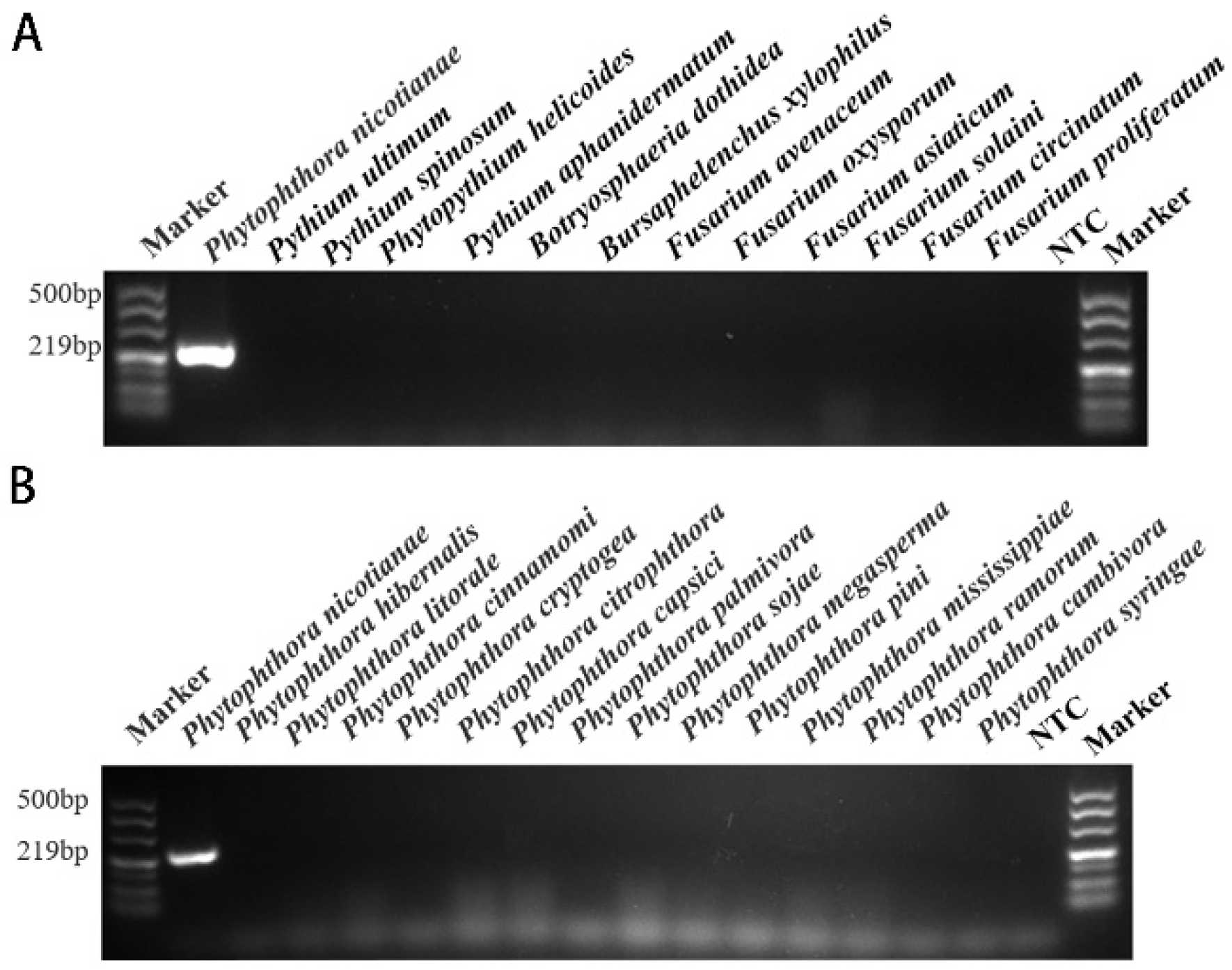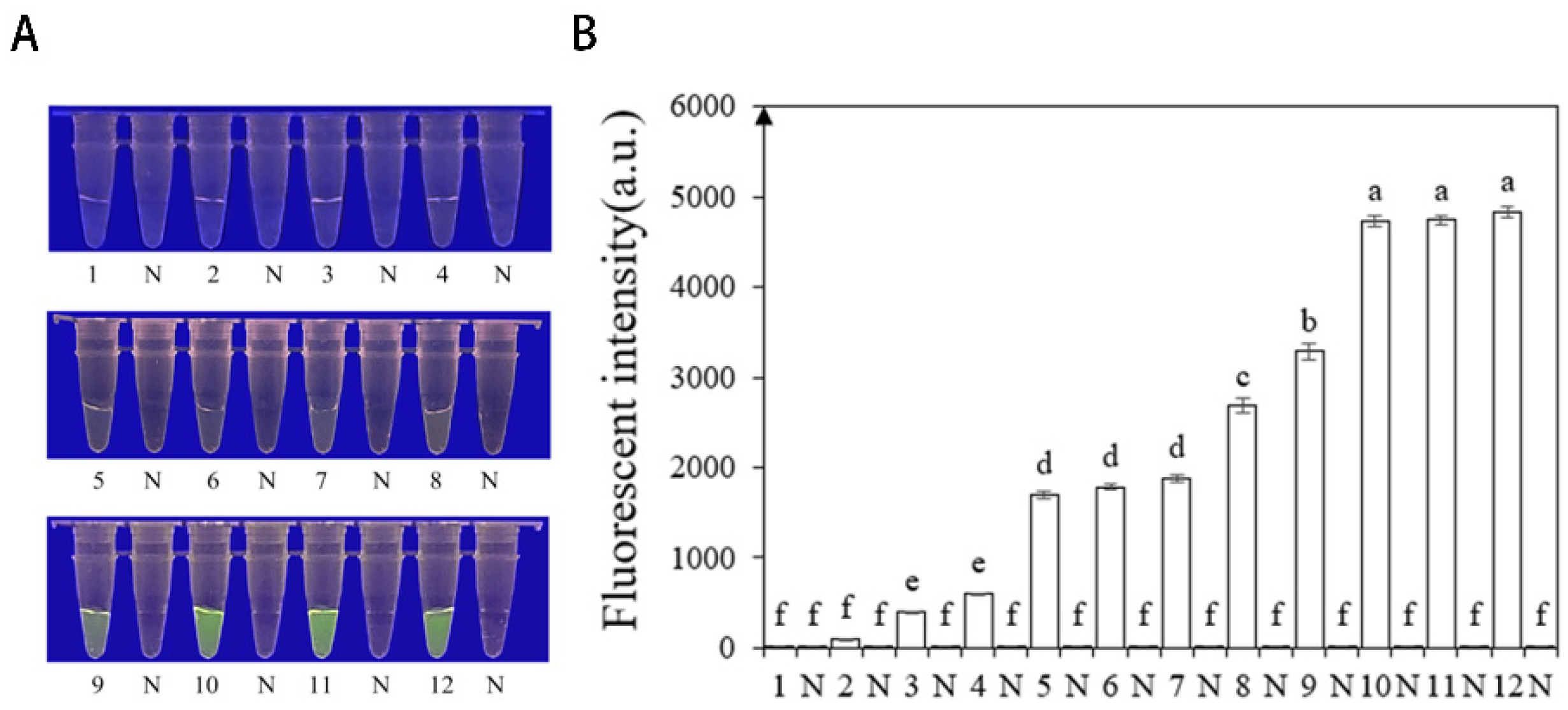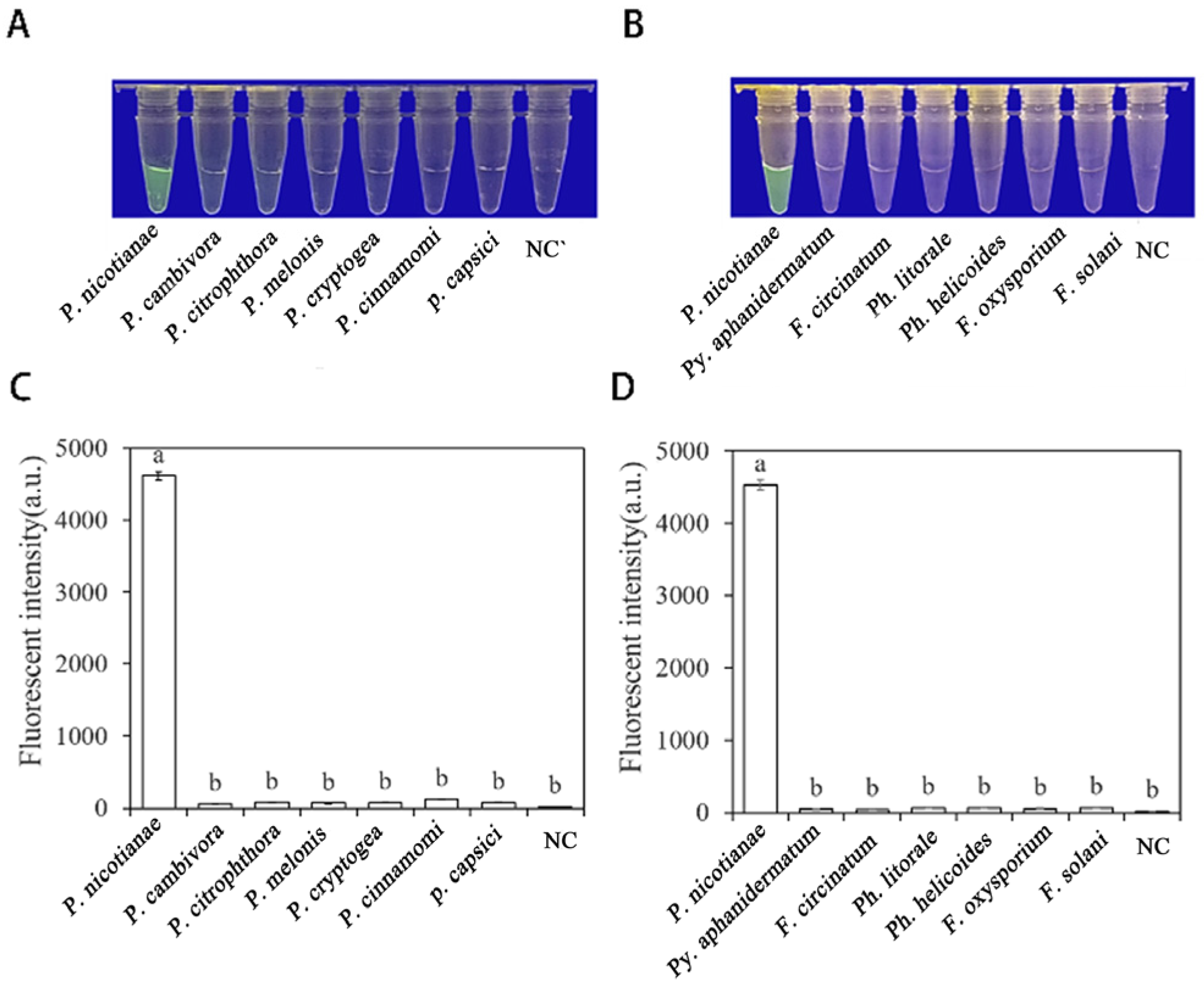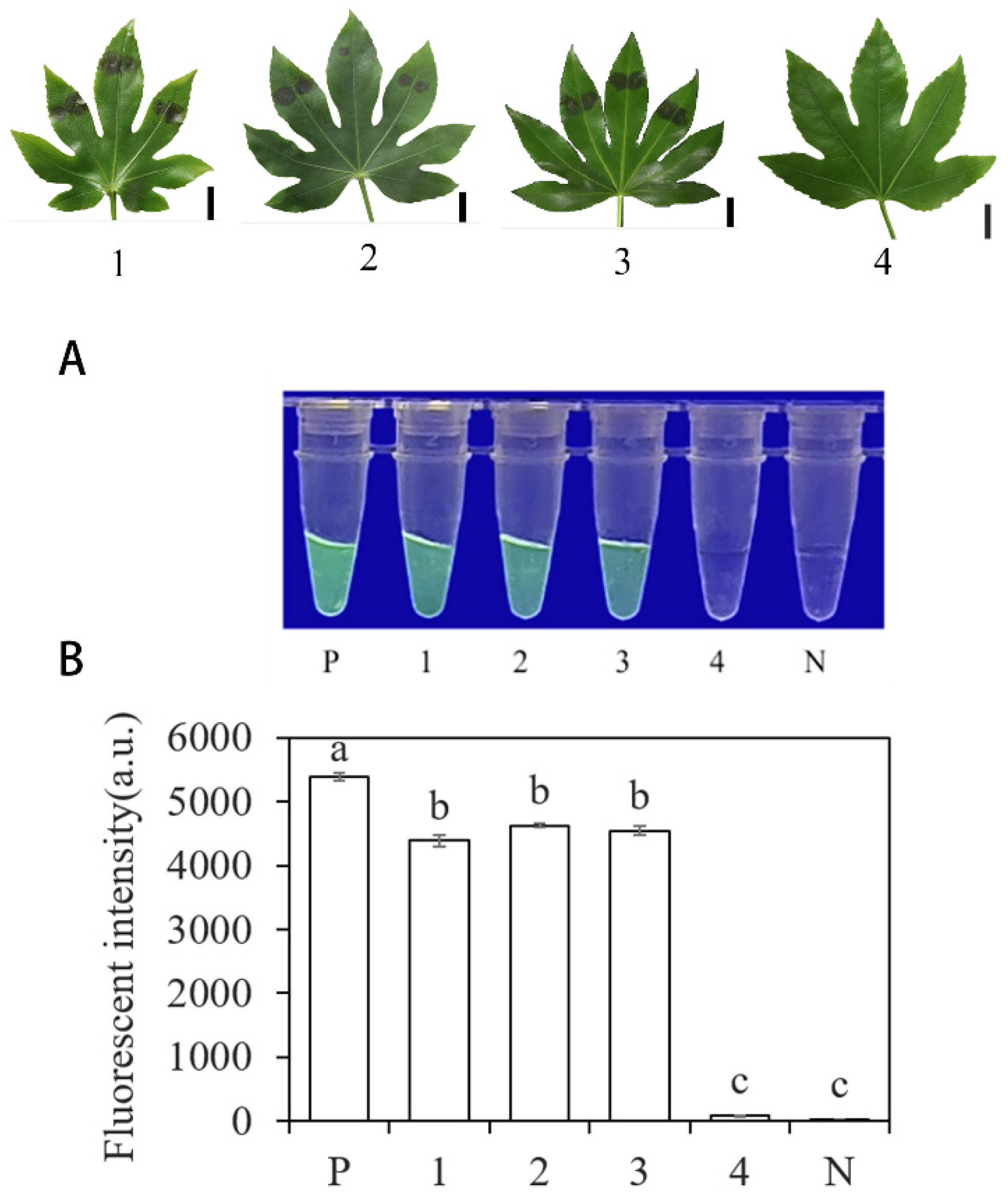Rapid and Efficient Molecular Detection of Phytophthora nicotianae Based on RPA-CRISPR/Cas12a
Abstract
:1. Introduction
2. Materials and Methods
2.1. Maintenance of Isolates and DNA Extraction
2.2. Design of RPA Primers, crRNA, and ssDNA Reporter
2.3. The RPA-CRISPR/Cas12a Assay
2.4. Optimized of RPA-CRISPR/CAS12a for Detection of P. nicotianae
2.5. Conventional PCR Assay
2.6. Specificity and Sensitivity of RPA-CRISPR/Cas12a Detection Method
2.7. RPA-CRISPR/Cas12a Method for Detection of P. nicotianae in Artificially Inoculated Fatsia japonica
3. Results and Analysis
3.1. Specific Primers for Detecting P. nicotianae
3.2. Optimizing the RPA-CRISPR/Cas12a Assay for the Detection of P. nicotianae
3.3. Specificity of RPA-CRISPR/Cas12a Assay in Rapid Detection of P. nicotianae
3.4. Determining the Sensitivity of the RPA-CRISPR/Cas12a Assay
3.5. RPA-CRISPR/Cas12a Method for Detection of P. nicotianae in Artificially Inoculated Fatsia japonica
4. Discussion
5. Conclusions
Supplementary Materials
Author Contributions
Funding
Data Availability Statement
Acknowledgments
Conflicts of Interest
References
- Kroon, L.P.; Brouwer, H.; De Cock, A.W.; Govers, F. The genus Phytophthora anno 2012. Phytopathology 2012, 102, 348–364. [Google Scholar] [CrossRef]
- Martin, F.N.; Blair, J.E.; Coffey, M.D. A combined mitochondrial and nuclear multilocus phylogeny of the genus Phytophthora. Fungal Genet. Biol. 2014, 66, 19–32. [Google Scholar] [CrossRef]
- Meng, Y.; Zhang, Q.; Ding, W.; Shan, W. Phytophthora parasitica: A model oomycete plant pathogen. Mycology 2014, 5, 43–51. [Google Scholar] [CrossRef]
- Panabières, F.; Ali, G.S.; Allagui, M.B.; Dalio, R.J.; Gudmestad, N.C.; Kuhn, M.; Roy, S.G.; Schena, L.; Zampounis, A. Phytophthora nicotianae diseases worldwide: New knowledge of a long-recognised pathogen. Phytopathol. Mediterr. 2016, 55, 20–40. [Google Scholar]
- Aloi, F.; Parlascino, R.; Conti, T.S.; Faedda, R.; Pane, A.; Cacciola, S.O. Phytophthora pseudocryptogea, P. nicotianae and P. multivora Associated to Cycas revoluta: First Report Worldwide. Plants 2023, 12, 1197. [Google Scholar] [CrossRef] [PubMed]
- Zhou, J.; Xu, T.; Xu, X.; Dai, T.; Liu, T. The New Report of Root Rot on Fatsia japonica Caused by Phytophthora nicotianae in China. Forests 2023, 14, 1459. [Google Scholar] [CrossRef]
- Zhang, K.; Sun, Z.; Shi, K.; Yang, D.; Bian, Z.; Li, Y.; Gou, H.; Jiang, Z.; Yang, N.; Chu, P.; et al. RPA-CRISPR/Cas12a-Based Detection of Haemophilus parasuis. Animals 2023, 13, 3317. [Google Scholar] [CrossRef] [PubMed]
- Guha, R.S.; Grünwald, N. The plant destroyer genus Phytophthora in the 21st century. Rev. Plant Pathol. 2014, 6, 387–412. [Google Scholar]
- Popkin, B. Urbanization, lifestyle changes and the nutrition transition. World Dev. 1999, 27, 1905–1916. [Google Scholar] [CrossRef]
- Machado, M.; Collazo, C.; Pena, M.; Coto, O.; Lopez, M.O. First report of root rot caused by Phytophthora nicotianae in avocado trees (Persea americana) in Cuba. New Dis. Rep. 2013, 28, 9. [Google Scholar] [CrossRef]
- Chen, X.; Ma, K.; Yi, X.; Xiong, L.; Wang, Y.; Li, S. The rapid and visual detection of methicillin-susceptible and methicillin-resistant Staphylococcus aureus using multiplex loop-mediated isothermal amplification linked to a nanoparticle-based lateral flow biosensor. Antimicrob. Resist. Infect. Control. 2020, 9, 111. [Google Scholar] [CrossRef] [PubMed]
- Liu, N.; Jiang, S.; Feng, S.; Shang, W.; Xing, G.; Qiu, R.; Li, C.; Li, S.; Zheng, W. A Duplex PCR Assay for Rapid Detection of Phytophthora nicotianae and Thielaviopsis basicola. Plant Pathol. J. 2019, 35, 172–177. [Google Scholar] [CrossRef] [PubMed]
- Das, A.K.; Nerkar, S.; Gawande, N.; Thakre, N.; Kumar, A. SCAR marker for Phytophthora nicotianae and a multiplex PCR assay for simultaneous detection of P. nicotianae and Candidatus Liberibacter asiaticus in citrus. J. Appl. Microbiol. 2019, 127, 1172–1183. [Google Scholar] [CrossRef] [PubMed]
- Li, M.; Asano, T.; Suga, H.; Kageyama, K. A Multiplex PCR for the Detection of Phytophthora nicotianae and P. cactorum, and a Survey of Their Occurrence in Strawberry Production Areas of Japan. Plant Dis. 2011, 95, 1270–1278. [Google Scholar] [CrossRef] [PubMed]
- Li, M.; Inada, M.; Watanabe, H.; Suga, H.; Kageyama, K. Simultaneous detection and quantification of Phytophthora nicotianae and P. cactorum, and distribution analyses in strawberry greenhouses by duplex real-time PCR. Microbes Environ. 2013, 28, 195–203. [Google Scholar] [CrossRef] [PubMed]
- Blaya, J.; Lacasa, C.; Lacasa, A.; Martínez, V.; Santísima-Trinidad, A.B.; Pascual, J.A.; Ros, M. Characterization of Phytophthora nicotianae isolates in southeast Spain and their detection and quantification through a real-time TaqMan PCR. J. Sci. Food Agric. 2015, 95, 1243–1251. [Google Scholar] [CrossRef] [PubMed]
- Yan, L.; Zhou, J.; Zheng, Y.; Gamson, A.S.; Roembke, B.T.; Nakayama, S.; Sintim, H.O. Isothermal amplified detection of DNA and RNA. Mol. Biosyst. 2014, 10, 970–1003. [Google Scholar] [CrossRef]
- Hieno, A.; Li, M.; Otsubo, K.; Suga, H.; Kageyama, K. Multiplex LAMP Detection of the Genus Phytophthora and Four Phytophthora Species, P. ramorum, P. lateralis, P. kernoviae, and P. nicotianae, with a Plant Internal Control. Microbes Environ. 2021, 36, ME21019. [Google Scholar] [CrossRef] [PubMed]
- Barreda-García, S.; Miranda-Castro, R.; de-Los-Santos-Álvarez, N.; Miranda-Ordieres, A.J.; Lobo-Castañón, M.J. Helicase-dependent isothermal amplification: A novel tool in the development of molecular-based analytical systems for rapid pathogen detection. Anal. Bioanal. Chem. 2018, 410, 679–693. [Google Scholar] [CrossRef]
- Walker, G.T.; Fraiser, M.S.; Schram, J.L.; Little, M.C.; Nadeau, J.G.; Malinowski, D.P. Strand displacement amplification—An isothermal, in vitro DNA amplification technique. Nucleic Acids Res. 1992, 20, 1691–1696. [Google Scholar] [CrossRef]
- Goo, N.I.; Kim, D.E. Rolling circle amplification as isothermal gene amplification in molecular diagnostics. BioChip J. 2016, 10, 262–271. [Google Scholar] [CrossRef] [PubMed]
- Miles, T.D.; Martin, F.N.; Coffey, M.D. Development of rapid isothermal amplification assays for detection of Phytophthora spp. in plant tissue. Phytopathology 2015, 105, 265–278. [Google Scholar] [CrossRef] [PubMed]
- Piepenburg, O.; Williams, C.H.; Stemple, D.L.; Armes, N.A. DNA Detection using recombination proteins. PloS Biol. 2016, 4, e204. [Google Scholar] [CrossRef]
- Li, J.; Macdonald, J.; von Stetten, F. Review: A comprehensive summary of a decade development of the recombinase polymerase amplification. Analyst 2018, 144, 31–67. [Google Scholar] [CrossRef] [PubMed]
- Knott, G.J.; Doudna, J.A. CRISPR-Cas guides the future of genetic engineering. Science 2018, 361, 866–869. [Google Scholar] [CrossRef]
- Danna, K.; Nathans, D. Specific cleavage of simian virus 40 DNA by restriction endonuclease of Hemophilus influenzae. Proc. Natl. Acad. Sci. USA 1979, 68, 2913–2917. [Google Scholar] [CrossRef] [PubMed]
- Pickar-Oliver, A.; Gersbach, C.A. The next generation of CRISPR-Cas technologies and applications. Nat. Rev. Mol. Cell Biol. 2019, 20, 490–507. [Google Scholar] [CrossRef] [PubMed]
- Gootenberg, J.S.; Abudayyeh, O.O.; Lee, J.W.; Essletzbichler, P.; Dy, A.J.; Joung, J.; Verdine, V.; Donghia, N.; Daringer, N.M.; Freije, C.A.; et al. Nucleic Acid Detection With CRISPR-Cas13a/C2c2. Science 2017, 356, 438–442. [Google Scholar] [CrossRef] [PubMed]
- Harrington, L.B.; Burstein, D.; Chen, J.S.; Paez-Espino, D.; Ma, E.; Witte, I.P.; Cofsky, J.C.; Kyrpides, N.C.; Banfield, J.F.; Doudna, J.A. Programmed DNA Destruction by Miniature CRISPR-Cas14 Enzymes. Science 2018, 362, 839–842. [Google Scholar] [CrossRef]
- Li, S.Y.; Cheng, Q.X.; Liu, J.K.; Nie, X.Q.; Zhao, G.P.; Wang, J. CRISPRCas12a has Both Cis- and Trans-Cleavage Activities on Single-Stranded DNA. Cell Res. 2018, 28, 491–493. [Google Scholar] [CrossRef]
- Wang, B.; Wang, R.; Wang, D.; Wu, J.; Li, J.; Wang, J.; Liu, H.; Wang, Y. Cas12aVDet: A CRISPR/Cas12a-Based Platform for Rapid and Visual Nucleic Acid Detection. Anal. Chem. 2019, 91, 12156–12161. [Google Scholar] [CrossRef] [PubMed]
- Liu, X.; Qiu, X.; Xu, S.; Che, Y.; Han, L.; Kang, Y.; Yue, Y.; Chen, S.; Li, F.; Li, Z. A CRISPR-Cas12a-Assisted Fluorescence Platform for Rapid and Accurate Detection of Nocardia cyriacigeorgica. Front. Cell. Infect. Microbiol. 2022, 12, 835213. [Google Scholar] [CrossRef]
- Xiong, Y.; Cao, G.; Chen, X.; Yang, J.; Shi, M.; Wang, Y.; Nie, F.; Huo, D.; Hou, C. One-pot platform for rapid detecting virus utilizing recombinase polymerase amplification and CRISPR/Cas12a. Appl. Microbiol. Biotechnol. 2022, 106, 4607–4616. [Google Scholar] [CrossRef]
- Su, A.; Liu, Y.; Cao, X.; Xu, W.; Liang, C.; Xu, S. A universal CRISPR/Cas12a-mediated AuNPs aggregation-based surface-enhanced Raman scattering (CRISPR/Cas-SERS) platform for virus gene detection. Sens. Actuators B-Chem. 2022, 369, 132295. [Google Scholar] [CrossRef]
- Ramachandran, A.; Huyke, D.A.; Sharma, E.; Huang, M.K.; Banaei, C.N.; Pinsky, B.A.; Santiago, J.G. Electric field-driven microfluidics for rapid CRISPR-based diagnostics and its application to detection of SARS-CoV-2. Proc. Natl. Acad. Sci. USA 2020, 117, 29518–29525. [Google Scholar] [CrossRef] [PubMed]
- James, A.M.; Baker, M.B.; Bao, G.; Searles, C.D. MicroRNA Detection Using a Double Molecular Beacon Approach: Distinguishing Between miRNA and Pre-miRNA. Theranostics 2017, 7, 634–646. [Google Scholar] [CrossRef] [PubMed]
- Shen, L.; Hu, J.; Chen, Y.; Tan, J.; Ye, J. Cloning, Bioinformatics Analysis and Physiological Function of the Pine Wood Nematode Bxadh2 Gene. Forests 2023, 14, 1283. [Google Scholar] [CrossRef]
- Tingting, D.; Xiao, Y.; Tao, H. A Novel LAMP Assay for the Detection of Phytophthora cinnamomi Utilizing a New Target Gene Identified From Genome Sequences. Plant Dis. 2019, 103, 3101–3107. [Google Scholar]
- Nagel, J.H.; Gryzenhout, M.; Slippers, B.; Wingfield, M.J. The occurrence and impact of Phytophthora on the african continent. In Phytophthora—A Global Perspective; Lamour, E., Ed.; CAB International: Wallingford, Oxfordshire, UK, 2013; pp. 204–214. [Google Scholar]
- Jiao, J.; Kong, K.; Han, J.; Song, S.; Bai, T.; Song, C.; Wang, M.; Yan, Z.; Zhang, H.; Zhang, R.; et al. Field detection of multiple RNA viruses/viroids in apple using a CRISPR/Cas12a-based visual assay. Plant Biotechnol. 2021, 19, 394–405. [Google Scholar] [CrossRef]
- Gootenberg, J.S.; Abudayyeh, O.O.; Kellner, M.J.; Joung, J.; Collins, J.J.; Zhang, F. Multiplexed and portable nucleic acid detection platform with Cas13, Cas12a, and Csm6. Science 2018, 360, 439–444. [Google Scholar] [CrossRef]
- Shi, Y.; Kang, L.; Mu, R.; Xu, M.; Duan, X.; Li, Y.; Yang, C.; Ding, J.W.; Wang, Q.; Li, S. CRISPR/Cas12a-Enhanced Loop-Mediated Isothermal Amplification for the Visual Detection of Shigella flexneri. Front. Bioeng. Biotechnol. 2022, 10, 845688. [Google Scholar] [CrossRef] [PubMed]








| Number | (Sub) Clade | Species | Location | Host/Substrate | Isolate | CRISPR/Cas12a Deteciton Results |
|---|---|---|---|---|---|---|
| 1 | Oomycete | Phytophthora nicotianae | Fujian, China | Nicotiana tabacum | Pn1 | + |
| 2 | Phytophthora nicotianae | Jiangsu, China | Lycopersicum sp. | Pn2 | + | |
| 3 | Phytophthora nicotianae | Jiangsu, China | Sophora sinensis | Pn3 | + | |
| 4 | Phytophthora nicotianae | Jiangsu, China | Citrus sp. | Pn4 | + | |
| 5 | Phytophthora nicotianae | Yunnan, China | Nicotiana tabacum | Pni1 | + | |
| 6 | Phytophthora melonis | Jiangsu, China | Cucumis sativus | PMNJHG1 | − | |
| 7 | Phytophthora melonis | Jiangsu, China | Cucumis sativus | PMNJHG2 | − | |
| 8 | Phytophthora melonis | Jiangsu, China | Cucumis sativus | PMNJHG3 | − | |
| 9 | Phytophthora melonis | Jiangsu, China | Benincasa hispida | PMNJDG1 | − | |
| 10 | Phytophthora citrophthora | Jiangsu, China | Citrus reticulata Blanco | Pcit | − | |
| 11 | Phytophthora cryptogea | Jiangsu, China | Solanum lycopersicum | Pcr1 | − | |
| 12 | Phytophthora cinnamomi | Puerto Rico | Persea americana | 23B2 | − | |
| 13 | Phytophthora cinnamomi | USA | Pieris sp. | 7574 | − | |
| 14 | Phytophthora cinnamomi | Taiwan | Castanopsis sp. | 7560 | − | |
| 15 | Phytophthora cinnamomi | Shanxi, China | Cupressus funebris | CHAP1 | − | |
| 16 | Phytophthora cinnamomi | Jiangsu, China | Rhododendron pulchrum | CI | − | |
| 17 | Phytophthora cambivora | Shanghai, China | Malus domestica Borkh | Pc1 | − | |
| 18 | Phytophthora cambivora | USA | Castanea sativa | CBS 248.60 | − | |
| 19 | Phytophthora capsici | Jiangsu, China | Capsicum annuum | Pcap1 | − | |
| 20 | Phytophthora pini | Jiangsu, China | Rhododendron pulchrum | Ppini | − | |
| 21 | Phytophthora sojae | USA | Glycine max | P6497 | − | |
| 22 | Phytophthora ilicis | The Netherlands | Ilex aquifolium | CBS114348 | − | |
| 23 | Phytophthora palmivora | Yunnan, China | Iridaceae | Ppa1 | − | |
| 24 | Phytophthora megasperma | USA | Matthiola incana | CBS305.36 | − | |
| 25 | Phytophthora megasperma | Mississippi, USA | Irrigation water | 57J3 | − | |
| 26 | Phytophthora brassicae | Canda | Brassica sp. | CBS178.87 | − | |
| 27 | Phytophthora hibernalis | Shanghai, China | Malus domestica Borkh | 947 | − | |
| 28 | Phytophthora hibernalis | USA | Unknown | CBS 132.23 | − | |
| 29 | Phytophthora ramorum | United Kingdom | Quercus palustris | EU1 2275 | − | |
| 30 | Phytophthora syringae | Shanghai, China | Malus domestica Borkh | 9099 | − | |
| 31 | Phytopythium litorale | Jiangsu, China | Rhododendron simsii | PC-dj1 | − | |
| 32 | Phytopythium litorale | Jiangsu, China | Rhododendron simsii | PC-dj2 | − | |
| 33 | Phytopythium helicoides | Jiangsu, China | Rhododendron simsii | PH-C | − | |
| 34 | Phytopythium helicoides | Jiangsu, China | Rhododendron simsii | PF-he2 | − | |
| 35 | Phytopythium helicoides | Jiangsu, China | Rhododendron simsii | PF-he3 | − | |
| 36 | Pythium aphanidermatum | Jiangsu, China | Nicotiana tabacum | NT-ap1 | − | |
| 37 | Pythium spinosum | Jiangsu, China | Oryza sativa | OS-sp1 | − | |
| 38 | Pythium ultimum | Jiangsu, China | Glycine max | GM-ul1 | − | |
| 39 | Fungi | Fusarium acuminatum | Sichuan, China | Rhizophora apiculata | Fac1 | − |
| 40 | Fusarium asiaticum | Jiangsu, China | Triticum aestivum | Fas1 | − | |
| 41 | Fusarium avenaceum | Jiangsu, China | Glycine max | Fav1 | − | |
| 42 | Fusarium circinatum | Shanghai, China | Pinus sp. | A045-1 | − | |
| 43 | Fusarium circinatum | Shanghai, China | Pinus sp. | A045-2 | − | |
| 44 | Fusarium oxysporium | Jiangsu, China | Gossypium sp. | Fox1 | − | |
| 45 | Fusarium oxysporium | Jiangsu, China | Pinus sp. | Fox2 | − | |
| 46 | Fusarium proliferatum | Jiangsu, China | Pinus sp. | Fpr1 | − | |
| 47 | Fusarium proliferatum | Jiangsu, China | Oryza sativa | Fpr2 | − | |
| 48 | Fusarium solani | Jiangsu, China | Gossypium sp. | Fso1 | − | |
| 49 | Fusarium solani | Jiangsu, China | Glycine max | Fso2 | − | |
| 50 | Botryosphaeria dothidea | Jiangsu, China | Koelreuteria paniculata | Bci1 | − | |
| 51 | Nematode | Bursaphelenchus xylophilus | Jiangsu, China | Pinus thunbergii | JS-1 | − |
| 52 | Bursaphelenchus xylophilus | Anhui, China | Pinus thunbergii | AH15 | − | |
| 53 | Bursaphelenchus xylophilus | Liaoning, China | Pinus thunbergii | LN11 | − | |
| 54 | Bursaphelenchus xylophilus | Guangxi, China | Pinus thunbergii | GX04 | − |
Disclaimer/Publisher’s Note: The statements, opinions and data contained in all publications are solely those of the individual author(s) and contributor(s) and not of MDPI and/or the editor(s). MDPI and/or the editor(s) disclaim responsibility for any injury to people or property resulting from any ideas, methods, instructions or products referred to in the content. |
© 2024 by the authors. Licensee MDPI, Basel, Switzerland. This article is an open access article distributed under the terms and conditions of the Creative Commons Attribution (CC BY) license (https://creativecommons.org/licenses/by/4.0/).
Share and Cite
Zang, J.; Dai, T.; Liu, T.; Xu, X.; Zhou, J. Rapid and Efficient Molecular Detection of Phytophthora nicotianae Based on RPA-CRISPR/Cas12a. Forests 2024, 15, 952. https://doi.org/10.3390/f15060952
Zang J, Dai T, Liu T, Xu X, Zhou J. Rapid and Efficient Molecular Detection of Phytophthora nicotianae Based on RPA-CRISPR/Cas12a. Forests. 2024; 15(6):952. https://doi.org/10.3390/f15060952
Chicago/Turabian StyleZang, Jiahui, Tingting Dai, Tingli Liu, Xiaoqiao Xu, and Jing Zhou. 2024. "Rapid and Efficient Molecular Detection of Phytophthora nicotianae Based on RPA-CRISPR/Cas12a" Forests 15, no. 6: 952. https://doi.org/10.3390/f15060952





